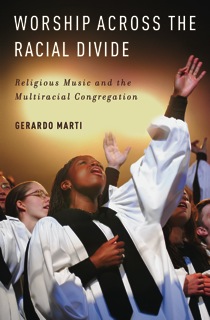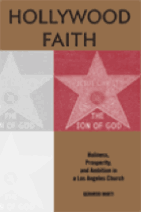Church Marketing Sucks, a website concerned with the use of contemporary marketing techniques by church leaders, recently provided a list of great media resources for churches freely available online. Through sites like these, we have a privileged window into American religion. Why? Because understanding the circulation of these media materials gives us an alternative means for understanding the widespread diffusion of "contemporary" church culture. Image by mufan96 via Flickr
Image by mufan96 via Flickr
We know contemporary churches use rented facilities. Not just movie theaters and high school auditoriums--churches are using bars and coffeehouses, community centers and warehouses, even lake shores and parking lots. How do these church leaders focus spiritual attention in these architecturally challenging sites?
Well, what's happening is that even churches who do not have specially-designed or "megachurch" aesthetics are adopting sharp media imagery to promote an exciting "vibe" that directs devotional attention and speaks to quality (and money) even when the church is just starting out.
Take a look through the
free resource sites listed by Church Marketing Sucks below. Each of these congregational ministries have longtime experience producing entire suites of visual materials that compliment and accentuate message series:
Clicking and exploring these sites, you get a sense of what non-high liturgy, "contemporary" churches are bringing into their services.
(For church-researcher types, these materials provide fodder for understanding seeker churches, new paradigm churches, and emerging adult spirituality.)
But, I'm writing this post to make a particular point: The availability of these materials points out an aspect of the modern diffusion of church culture. Here's what I see.

The internet is allowing more easy accessibility to media resources. Churches which have produced these materials (and are frequently asked by scores of other church leaders who literally
salivate over obtaining such things) are seeing the extension of their local church ministry as giving away these resources--at zero cost.
See, churches that produce these materials are well aware of the money and time invested in the creation of media materials that have an inherent disposability to them. They'll never be used again in their church (since churches don't "repeat" sermon series). So they are happy to have them used by others and see their investment put to good use by others.
In other words, providing media resources to other churches (after they have been used in the base church) is understood to be part of the missional outreach of the congregation.Graphic materials are viewed as tools (modern, necessary, missionary tools) that can be easily adapted by like-minded ministries who are perceived to be essentially partnering with them to spread a message they already believe should be widely promoted.

Because these media items are used in many different churches across the nation (perhaps the anglophone world), and because church attenders are highly unlikely to know the materials they see were originally used somewhere else,
there is an unacknowledged yet powerful diffusion of Christian visual culture -- at last a type of Christian culture.
And because we have not studied this, I speculate that the diffusion of style, ambiance, and ethos of religion embedded within these media materials is reinforcing particular boundaries of similarity and identity.
In the research literature, this is a type of "institutional isomorphism." But I won't go into all that now. It's enough to say that researchers DiMaggio and Powell* defined imitating or "Mimetic Processes" as coming from similar external conditions. In particular:
Uncertainty encourages imitation.
What does this mean for how "contemporary" church culture is widely reproduced?
Let's look at how this works. Using DiMaggio and Powell's framework, predictors of similarity (or "isomorphism") are based on premises like this:
Principle 1: The greater the centralization of resource supply, the more it will change to resemble the organizations it is dependent upon.
Application 1: There are only a few churches willing to give away these media materials, so the dependency on these few churches raises their influence as models for how to "do church."
Principle 2: The more uncertainty, the more an organization will model it's structure after successful firms.
Application 2: The means to growing new (and struggling) churches is highly uncertain, so leaders look to the successes of other, usually much larger and media-rich, churches.
Principle 3: The more ambiguous the goals, the more an organization will mimic a successful one to establish legitimacy.
Application 3: A mission statement like "Reaching our community with the gospel" is quite ambiguous, so church leaders quickly become alerted to widely accepted models of ministry and absorb their media practices.
These are not exhaustive, and certainly the principles are not directed soley toward understanding the use of media. Nevertheless, these principles provide a quick peek into the dynamics of isomorphism that can be applied.
Other important aspects are how organizational models can be diffused is through employee migration, which in the case of churches would include the movement of clergy, lay leaders, as well as members between churches. Larger churches with well-institutionalized media ministries more quickly diffuse their media-intelligent people in comparison with smaller churches which are not likely to have as extensive of media practices.
Also, organizational models are spread by consulting firms, which in the case of leaders is usually accomplished through church leader conferences. Highlighting and discussing the use of media is a common aspect of "contemporary" church conferences.
 Image via Wikipedia
Image via Wikipedia





